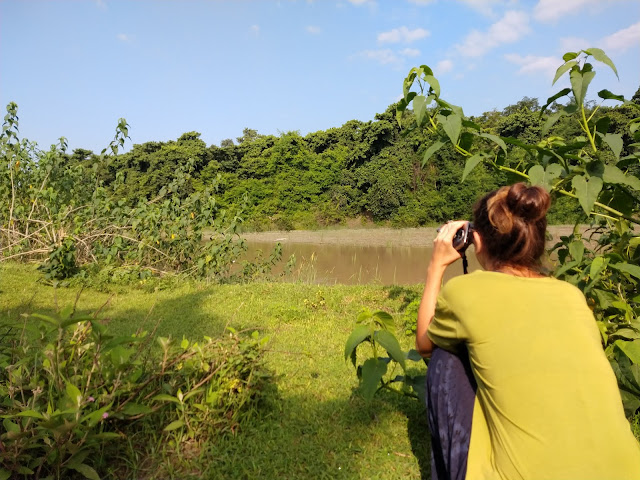Mugger Crocodiles near our lodge
The Marsh Mugger Crocodile (Crocodylus palustris) is a crocodile of medium to large size with the broadest snout of all the living members of the genus Crocodylus.
In the monsoon season, even though it's the low season in our Lodge and Bardia National Park, it's more than possible to see incredible creatures like this animal; we have expertised guides who are capable of showing you the area and finding the best spots in order to see animals in the wild.
In the last few weeks we have seen this specimen regularly, close to our lodge and could enjoy and study its movements and behaviour in close proximity.
They are more alligator-like than any other crocodile, especially in their rounded snout, as most crocodiles have a snout that is pointier. Like most crocodilians, muggers feature a flat head where their eyes, ears and nose are on top. This enables them to see, hear and breathe above water when their bodies are underwater. They have webbed feet but do not use them for swimming, using their strong, flat tail instead.
In the monsoon season, even though it's the low season in our Lodge and Bardia National Park, it's more than possible to see incredible creatures like this animal; we have expertised guides who are capable of showing you the area and finding the best spots in order to see animals in the wild.
In the last few weeks we have seen this specimen regularly, close to our lodge and could enjoy and study its movements and behaviour in close proximity.
They are more alligator-like than any other crocodile, especially in their rounded snout, as most crocodiles have a snout that is pointier. Like most crocodilians, muggers feature a flat head where their eyes, ears and nose are on top. This enables them to see, hear and breathe above water when their bodies are underwater. They have webbed feet but do not use them for swimming, using their strong, flat tail instead.
 |
| Marsh Mugger which has been seen regularly, close to our lodge in the last few weeks. |
The mugger crocodile occurs in the Indian subcontinent as well as surrounding countries: Sri Lanka in the east, Iran in the west, and also Pakistan and Nepal. This species is found in freshwater lakes, marshes and ponds, and has also adapted well to reservoirs, human-made ponds, irrigation canals, and coastal saltwater lagoons. This crocodile likes shallow water of no more than 5m deep, and it avoids fast-flowing rivers. It will sometimes bury itself into the mud to avoid the searing heat in the dry season.
 |
| Viewing a large Marsh Mugger on the opposite bank of the river, 5 min' from our lodge. |
Muggers are highly social and their social behavior includes gregarious behavior, communication, territorial activities, and dominance interactions. Between adults and also adults and their young there is a much vocalization. Most of the socializing takes place during the seasonal mating activities. Body postures like snout raising and tail thrashing are used by males when establishing territories and trying to gain dominance before courtship and mating.
Like other crocodile species, activities include basking, diving and swimming. In addition, a unique and important activity is burrowing. Burrows are used for thermo-regulation during hot and cold periods of the day. These crocodiles leave their tunnels at night to seek food.
This species can migrate over land for in search of new territory, and they can chase prey for short distances on land. They are adapted better than most other crocodiles to life on land.
Sometimes exceeding 15ft in length, the crocodile is primarily carnivorous, eating mostly fish, frogs, crustaceans, mammals, birds, and sometimes monkeys and squirrels.
 |
| A large impressive specimen which has been seen regularly over the past few weeks, 5 min' from the lodge. |
The main threats to this animal come from destruction of its habitat and illegal hunting for its skin and for the alternative medicine market. Another threat is egg collection. These crocodiles are also notorious fish stealers, eating ensnared fish, and sometimes they themselves become caught in a fish net and drown.
Overall, currently mugger crocodiles are classified as Vulnerable (VU), but their numbers today remain stable. According to the IUCN Red List, there are 200-300 mature individuals in Nepal, mainly in Bardia National Park.


Comments
Post a Comment